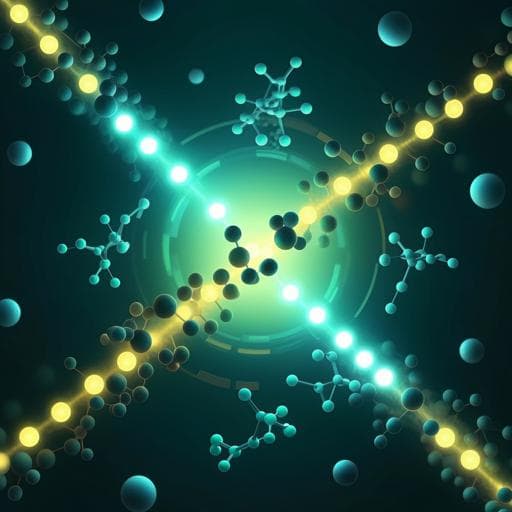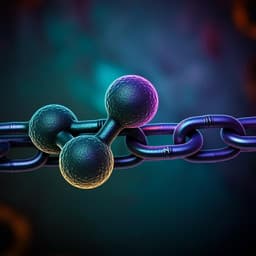
Chemistry
Sustainable production of hydrogen with high purity from methanol and water at low temperatures
S. Zhang, Y. Liu, et al.
Discover how Pt single-atoms and frustrated Lewis pairs (FLPs) on porous CeO₂ nanorods achieve efficient, additive-free H₂ generation at low CO levels through aqueous-phase reforming of methanol. This innovative research conducted by Sai Zhang, Yuxuan Liu, Mingkai Zhang, Yuanyuan Ma, Jun Hu, and Yongquan Qu paves the way for flexible hydrogen utilization.
~3 min • Beginner • English
Introduction
Hydrogen is a clean energy carrier with high calorific value, but its storage and transport are challenged by flammability, explosibility, and high liquefaction pressures. Liquid organic hydrogen carriers mitigate these issues. Among them, methanol—sustainably produced from biomass or CO2 hydrogenation—offers high hydrogen content (up to 18.8 wt% via reforming with water) and benefits from mature storage and transport technologies, making it a leading candidate. Homogeneous catalysts can release hydrogen below 100 °C but typically require strong bases (e.g., KOH, NaOH) to activate CH3OH/H2O and neutralize generated acids, which is undesirable environmentally and economically. Heterogeneous Pt-, Ru-, and Pd-based systems can work without additives, but generally need high temperatures (≥250 °C) and often produce H2 with high CO contamination. Recent progress with atomically dispersed Pt on α-MoC reduced operating temperatures to ~150 °C, yet further decreasing temperature while maintaining satisfactory H2 rates and purity remains difficult. Therefore, high-efficiency catalysts that enable in situ H2 release at even lower temperatures with suppressed CO are highly desirable for scalable hydrogen production and advancing a methanol-based hydrogen economy.
Literature Review
Prior work on liquid organic hydrogen carriers has highlighted methanol for its high gravimetric hydrogen density and established logistics. Homogeneous catalysts can function at <100 °C but require high concentrations of strong base to activate substrates and maintain activity by neutralizing formic acid/CO2, limiting sustainability. Heterogeneous catalysts based on Pt, Ru, or Pd operate without additives but typically require ≥250 °C and yield H2 streams with significant CO, problematic for downstream fuel cell applications. Advances with atomically dispersed Pt on α-MoC have pushed APRM temperatures down to ~150 °C, yet achieving efficient, additive-free hydrogen generation at even lower temperatures with very low CO remains rare. Separately, reducible oxides like CeO2 can activate H2O via Lewis acid-base interactions, and frustrated Lewis pairs (FLPs) formed by adjacent Ce3+ and lattice oxygen at oxygen vacancies on CeO2(110) have been shown to promote water activation. Single-atom Pt sites are effective for methanol activation. Integrating these insights motivates dual-site catalysts combining single-atom Pt for methanol activation with FLPs for water activation.
Methodology
Catalyst design and theory: Density functional theory (DFT) evaluated activation steps relevant to APRM. H2O dissociation barriers were calculated on Pt(111) (1.12 eV, kinetically unfavorable) and on CeO2(110) surfaces with differing defect densities: ideal (0.58 eV), with one oxygen vacancy (adsorptive dissociation), and with FLP sites (two adjacent oxygen vacancies; adsorptive dissociation and thermodynamically favored). Dual-active site models were constructed with single-atom Pt at oxygen vacancies (type I: Pt separated from FLP; type II: Pt adjacent to FLP). DFT showed the water–gas shift-like reforming of *CO with *OH had a barrier of 0.89 eV on adjacent Pt1–FLP (type II) vs 2.15 eV on Pt(111). CH3OH decomposition barriers were compared on Pt(111), Pt1/CeO2(110), and Pt1/CeO2(110)-FLP, revealing a large reduction to 0.23 eV on Pt1/CeO2(110)-FLP for CH3OH dissociation.
Synthesis: Porous nanorods of CeO2 (PN-CeO2) were prepared by a two-step hydrothermal method to generate highly defective CeO2(110)-rich surfaces (length ~65 nm, diameter ~7 nm, BET surface area 109 m2 g−1; abundant oxygen vacancies with surface Ce3+ fraction ~30.8%). Single-atom Pt was deposited onto PN-CeO2 via a photo-assisted deposition process to yield Pt1/PN-CeO2 with 0.36 wt% Pt.
Characterization: Morphology and dispersion were examined by TEM/HAADF-STEM (single-atom Pt observed) and EDS mapping (uniform Pt distribution). XANES (Pt K-edge) and EXAFS confirmed ionic Pt coordinated to O (Pt–O peak at ~1.63 Å) with no Pt–Pt coordination, indicating atomic dispersion. DRIFTS with CO probe identified linear CO on isolated Pt2+ (~2090 cm−1), with distinct peaks (2099 and 2076 cm−1) assigned to type I and type II Pt1–FLP configurations. XPS quantified Ce3+ and oxygen defect fractions; BET determined pore structure. Valence-band XPS probed d-band shifts. FTIR adsorption studies investigated methanol-derived methoxy intermediates.
Catalytic testing: APRM was performed base-free in a closed system under initial 0.4 MPa N2 with CH3OH/H2O = 1:1 (40 mL MeOH, 18 mL H2O) and 50 mg catalyst at various temperatures (100–180 °C). H2 generation rates, turnover frequencies (TOF, per Pt atom), and CO selectivity were measured. Stability was assessed over cycling at 165 °C (1 h per cycle, 10 cycles) and 120 °C (3 h per cycle, 10 cycles). Reference catalysts: Pt nanoparticles on Al2O3, TiO2, and C (0.5 wt% Pt) were prepared by impregnation; additional CeO2 supports (nonporous nanorods NR-CeO2 and nanoparticles NP-CeO2) were synthesized to vary FLP density. Pt/ceia catalysts with controlled Pt particle sizes (0.32–5.1 wt% Pt) were prepared to modulate interfacial Pt atom fractions.
Kinetic/isotope studies: H/D isotope experiments compared kH2O/kD2O and kCH3OH/kCD3OD on Pt1/PN-CeO2, Pt/PN-CeO2, and Pt/NR-CeO2 to probe rate-determining steps and roles of FLPs vs Pt site structures. Arrhenius analysis provided apparent activation energies (Ea). Correlations of TOF with surface Ce3+ fraction (as FLP density proxy) and with the calculated numbers of interfacial, corner, edge, and facet Pt atoms were performed to identify active sites.
Key Findings
- Dual-site concept: DFT and experiments show FLP sites on CeO2(110) efficiently dissociate H2O (adsorptive dissociation on defective/FLP surfaces), while single-atom Pt promotes CH3OH activation; adjacent Pt1–FLP lowers the barrier for reforming *CO with *OH (0.89 eV vs 2.15 eV on Pt(111)).
- Catalytic performance at low temperature: Pt1/PN-CeO2 achieved H2 generation rates of 33 mol H2 molPt−1 h−1 at 120 °C (TOF 33 h−1) and 199 mol H2 molPt−1 h−1 at 135 °C. In a fixed-bed at 100 °C, 19.7 mol H2 molPt−1 h−1 was obtained. At 165 °C, the rate reached 1103 mol H2 molPt−1 h−1.
- CO suppression: CO selectivity was very low—0.027% at 120 °C, 0.032% at 135 °C, and 0.045% at 165 °C—yielding hydrogen with ~270 ppm CO at low temperature.
- Benchmarking: Under identical conditions at 135 °C, Pt1/PN-CeO2 outperformed Pt/Al2O3 (2.6), Pt/TiO2 (3.8), and Pt/C (0.7 mol H2 molPt−1 h−1) by 2–3 orders of magnitude, and rivaled or exceeded many homogeneous systems even without additives.
- Stability: Over 10 cycles, activity decreased modestly at 165 °C (1103 to 881 mol H2 molPt−1 per cycle) with CO selectivity <0.05% each cycle; at 120 °C, H2 generation remained 93–128 mol H2 molPt−1 per cycle with CO selectivity <0.03%. Catalyst morphology, Ce3+ levels, and FLP signatures were largely preserved; minor growth of Pt clusters at 165 °C was observed.
- Active site identification: TOF scaled with surface Ce3+ fraction (FLP density): Pt/PN-CeO2 (615 h−1) > Pt/NR-CeO2 (364 h−1) > Pt/NP-CeO2 (256 h−1). Size-dependent analysis showed the normalized TOF was constant only for interfacial Pt atoms, indicating they are the dominant active sites.
- Isotope and kinetics: kH2O/kD2O values indicated enhanced water activation via FLPs, most pronounced when all Pt atoms are interfacial (Pt1/PN-CeO2: 1.5; Pt/PN-CeO2: 2.2; Pt/NR-CeO2: 2.6). kCH3OH/kCD3OD decreased to 2.6 on Pt1/PN-CeO2 versus ~5.2 on nanoparticulate catalysts, evidencing facilitated methanol activation at single-atom Pt adjacent to Ce3+. Apparent Ea for H2 generation was 70.8 kJ mol−1 (Pt1/PN-CeO2), lower than Pt/PN-CeO2 (95.3) and Pt/NR-CeO2 (120.0 kJ mol−1).
- Spectroscopic insights: DRIFTS and FTIR detected linear CO on isolated Pt2+ and bridged methoxy intermediates involving single-atom Pt and adjacent Ce, supporting the dual-site mechanism. Valence-band XPS indicated a d-band shift consistent with weaker CO2 bonding and facilitated desorption.
Discussion
The study addresses the challenge of producing high-purity hydrogen from methanol and water at low temperatures without additives by integrating complementary active sites: single-atom Pt for methanol activation and FLP sites on defective CeO2(110) for water activation. This spatial and electronic cooperation accelerates both key steps—CH3OH dissociation and H2O splitting—and lowers the barrier for reforming adsorbed CO with hydroxyls, thereby enhancing H2 production while suppressing CO formation. Experimental correlations of activity with FLP density and identification of interfacial Pt atoms as the dominant active species substantiate the dual-site mechanism. The resulting catalyst delivers efficient APRM at temperatures down to 120 °C with CO in the tens to low hundreds of ppm, a substantial improvement over conventional heterogeneous systems and comparable to additive-assisted homogeneous catalysts. These results advance practical, safer liquid-phase hydrogen generation routes and bring methanol-based hydrogen utilization closer to feasibility, though further CO cleanup is needed for direct fuel-cell compatibility.
Conclusion
A dual-active site catalyst comprising atomically dispersed Pt and FLP sites on porous CeO2 nanorods enables additive-free aqueous-phase reforming of methanol at low temperatures with high H2 productivity and very low CO. DFT and experiments show FLPs on CeO2(110) facilitate near-barrierless water activation, while adjacent single-atom Pt sites significantly reduce the barrier for methanol dissociation (to ~0.23 eV) and promote subsequent reforming of *CO with *OH. Pt1/PN-CeO2 exhibits high rates at 120–165 °C with 0.027–0.045% CO and good cycling stability. This strategy provides a viable pathway for low-temperature, high-purity hydrogen generation from liquid carriers. Future work could focus on integrating in situ CO cleanup or further CO suppression to meet stringent fuel-cell specifications, optimizing FLP densities and Pt–FLP proximities, improving resistance to Pt sintering under prolonged operation, and scaling reactor designs for continuous processes.
Limitations
Although CO levels are greatly suppressed (~270 ppm at low temperature), the product hydrogen still requires purification for fuel cell applications. Some sintering or clustering of Pt was observed after high-temperature cycling (165 °C), correlating with modest activity loss. Performance was demonstrated under specific batch conditions (0.4 MPa N2, liquid-phase APRM); translation to continuous operations and varied feedstocks requires further validation. The study focuses on Pt/CeO2; broader generality to other metals/supports remains to be established.
Related Publications
Explore these studies to deepen your understanding of the subject.







